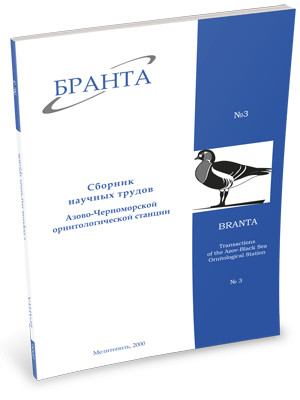
Transactions
of the Azov-Black Sea Ornithological Station



Significance of feeding resources in inner bays and estuaries of the Tuzlovskaya group of limans for migrating waders.
Kirikova T.A.
Materials were gathered during one expedition (August, 1999). 39 samples were taken from 13 stations using a benthos counting glass bottle with a total coverage area of 0.015 m2and immersion depth of 0.1 m2. Absolute census of waders was taken in different sites at the same time. There are such abbreviations in the work: ТГЛ - Tuzlovskaya group of limans, ПКП - potential feeding fields, УЗЛ – mouth zones of limans, AO - accumulative formations, ПОА – open coastal areas. In total 26 waders species were counted in Tuzlovskaya group of limans, 6459 individuals (table 3). 16 species (1 group) out of 26 used macrozoobenthos in their feeding. Its biomass was estimated separately for mouth zones of limans and open coastal areas. Аmong macrozoobenthos, Neanthes diversicolor (Muller, 1776) and Hydrobia acuta (Draparnaud, 1805) were the most valuable, constituting 97% of density and 86% of raw biomass (table 1). According to the preliminary results of the study, the hydrobiont biomass in the mouth zones of limans was higher than in the open coastal areas (table 1, 2): on Shagany - 2 times, on Alibei - 1.5 times, and these values were almost equal on Burnas. The area of feeding fields in mouth zones of limans was 2.8 km2 and there were 54 t of benthos available for waders. These values were equal to 1.2 km2 and 12.5 t in the open coastal areas. Feed resources 4.7 times exceeded waders needs. The study of stopovers of migrating waders has showed that major part of birds (93% of counted waders) was located in mouth zones and on accumulative formations of limans which were characterized by vast shallows, convenient for probing and rich in prey. The rest of waders using ‘gathering from surface’ as a way of feeding were located on the open coastal areas. The most numerous monospecies gatherings of waders were recorded in the mouth zones of limans.
Read the paper in a PDF file